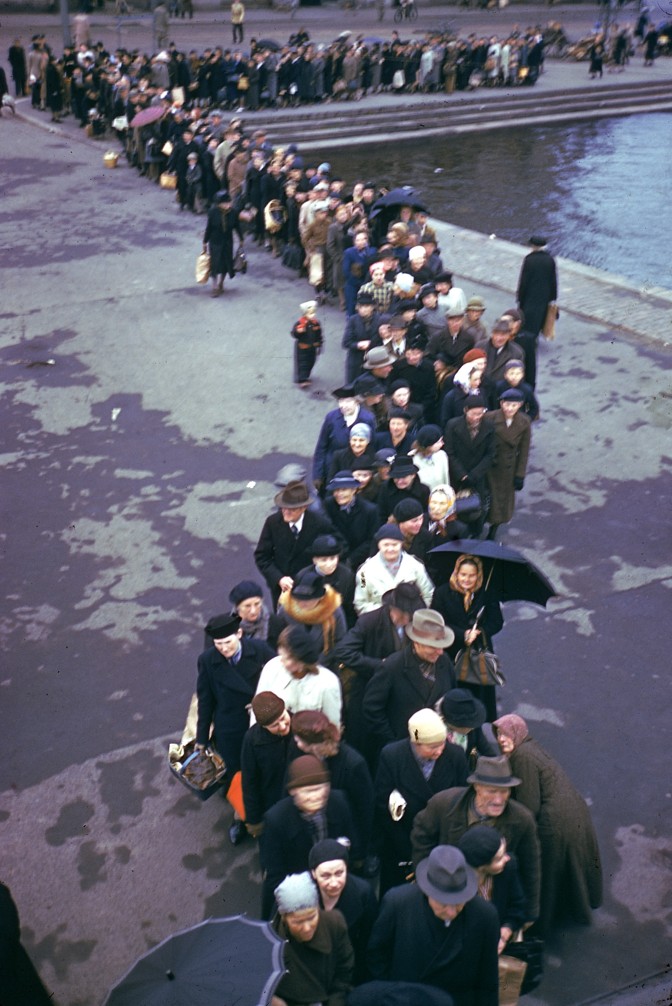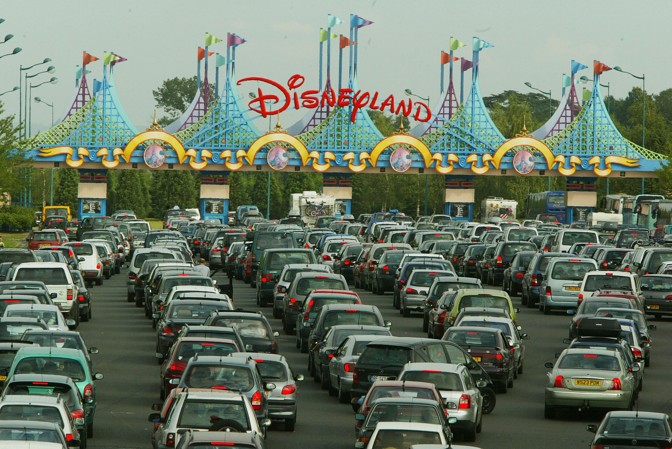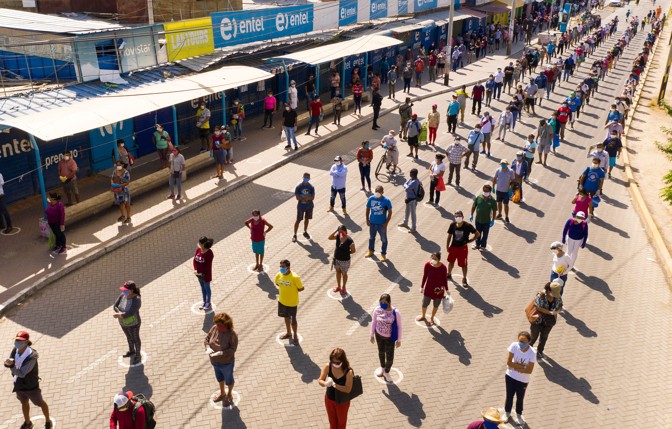On June 8, a crowd of maskless college students gathered outside Harper’s Restaurant and Brewpub in East Lansing, Michigan. Like other bars and restaurants in the United States, Harper’s had closed when the state imposed a shelter-at-home order in March. When the bar was allowed to reopen in June, at 50 percent capacity, fewer people could enter, and more had to wait. So the inevitable happened. The Brits call it a queue. Americans call it a line.
During the weeks that followed, Harper’s was linked to almost 200 COVID-19 cases, causing the brewpub to close its doors again temporarily. The owners had placed social-distancing markers on its stairs, but trying to get customers to comply on the public sidewalk proved challenging, they said in a statement.
Once a symbol of prestige (ever wait for hours to get into a club?), queues such as the one at Harper’s have become a symptom of the pandemic: hour-long lines wrapping around supermarkets. Students gearing up for remote learning, waiting in line to pick up equipment. Drive-through food banks with lines snaking for miles (and no end in sight). The election was already bound to produce bottlenecks, but in states such as Georgia, even early voting has brought hours-long lines as voters wait to cast their ballot, hoping they don’t catch the virus along the way.
[Read: An extinction event for America’s restaurants]
With social-distancing measures in place for the foreseeable future, queue management—once an esoteric subarea of logistics—is being recast as a health-and-wellness hero. The design practices and software tools that line experts have been working on for years might become as common as the queues they manage. If they do, Americans might finally rid themselves of the drudgery of waiting.
Disney is thought to have invented the switchback queue (the kind that snakes back and forth) during the 1964–65 World Fair in New York. Thanks to the more structured arrangement, guests stopped complaining about the long queues at the fair’s Disney attractions, even if the lines hadn’t actually gone down. Over the next few decades, the company perfected the waiting experience with a bonanza of abstract art, murals, props, and elaborate preshows designed to entertain but also distract its guests from the endless waiting. For example, the original Snow White’s Adventures queue mural in Fantasyland featured a colorful, four-panel teaser depicting seven scenes from the attraction to come.
Then more-sophisticated tools arrived, including the secret switchback—a themed queue that feels linear but is, in fact, a twist-and-turn maze filled with atmosphere and mystery. These sensational treks, still in use today, take Disney guests on compelling journeys to attractions such as Florida’s Space Mountain, which opened in 1975, and Tower of Terror, whose line winds through eerie, unkempt hotel gardens, a cobwebbed lobby, a spooky library, and a dark boiler room before reaching the maintenance-service elevators that function as ride vehicles.
In 1999, Disney’s FastPass allowed guests to pick their battles by skipping lines that weren’t worth the wait; later, FastPass+ allowed them to book rides in advance. Ever since, having fewer people in queues and more roaming the park has been the name of the game.
Even two decades ago, the concept wasn’t new. “We’ve had fast-track queuing from before I was born,” says the MIT operations researcher Richard Larson, who is widely considered the world’s leading expert on lines (he goes by the nickname Dr. Queue). “If you go into a nightclub, and you give the maître d’ a $20 bill, you’re fast-track queued,” he told me.
[Read: How to cut in line]
After almost four months behind closed doors, Disney resorts partially reopened in July, and wait times are inching closer to pre-pandemic levels (although the FastPass service is suspended). Now more than ever, guests are encouraged to download the My Disney Experience app and order food while waiting for their next adrenaline boost.
Larson calls this “a queue within a queue.” Like getting a drink at the bar while waiting for a table at that new Italian restaurant, nesting queues offer a two-for-one deal. You came all this way for the pasta, you may as well sip on a negroni while you wait. It’s a savvy business move, but it appeals to people because we like to stay productive. If your greatest asset is time, why waste it by waiting in line?
The pandemic has amplified that desire, because time wasted in line is also time spent in danger. Worried about lost business, retailers finally have a direct incentive to respond. Target now allows shoppers to make a digital reservation at their local store. In early September, the grocery chain Giant Eagle turned a GetGo convenience store in Fox Chapel, Pennsylvania, into a checkout-free experience. Customers download a mobile app, enter the store, and start shopping as normal. Computer vision and machine-learning technology track the products they put in their basket and tally them up as they shop. When ready for checkout, customers simply pay in the app and exit the store. Like a Disney park, the entire supermarket becomes a queue in disguise.

With a little ingenuity, a lot of capital—and some privacy trade-offs—airports could be next. Ty Osbaugh, a principal in the architecture firm Gensler’s aviation practice, has said that the key to a safe journey from curb to aircraft requires spreading out the load of queuing and congregation spaces throughout the terminal. A combination of self-check-in, timed slots at security checkpoints, and faster biometric screening could allow passengers to whiz through the airport with fewer delays—and less contact with fellow travelers. Delta Airlines has already implemented its first biometric terminal at Hartsfield-Jackson Airport in Atlanta, where, since 2018, passengers on international flights have been using facial-recognition technology from curb to gate. Montréal-Trudeau Airport has been experimenting with security-checkpoint time slots for years. But this all requires a radical overhaul of physical space.
In the meantime, Lavi Industries, a manufacturer of queue- and crowd-management products, has built transparent “germ shields” into its queue stanchions. Fentress Architects, the studio that designed the Tom Bradley Terminal at LAX, has proposed ditching the serpentine layout in favor of a multi-row, front-facing system divided by screens, to reduce face-to-face contact. And at the new Salt Lake City Airport, which opened in September but was designed pre-pandemic, the architecture firm HOK has embedded magnets in the ticket hall’s terrazzo floor. A new type of stanchion can be snapped into place along a magnetic grid, allowing for a flexible queuing space that can be reconfigured according to passenger flow.
“Because Salt Lake City is a new airport, we’ve designed everything to have adequate depth for queuing at ticketing, at security checkpoints—even the hold rooms are generously sized,” Matt Needham, the regional leader for aviation and transportation at HOK, says. Everything, right down to the restrooms.
Split across two aisles with a connecting space at their entrance, the bathrooms’ wishbone-shaped layout was originally inte
nded to allow half the space to remain open while the other half was being cleaned. In times of social distancing, it also allows for one-directional transit. To further increase capacity, there’s a restroom every 300 feet and the number of stalls corresponds to the number of seats on each aircraft serving a concourse, as well as the differing dwell times of men and women. Since the lines at women’s bathrooms are always longer, HOK tackled “potty parity” by adding stalls for us ladies.
[Read: How you know where you’re going when you’re in an airport]
“If all goes to plan, our design will result in no restroom lines,” Needham told me. And when a snowstorm grounds all flights and lines inevitably do form, the architects have borrowed a page from Disney’s early queue designs and commissioned murals that liven up the place and help pass the time while people wait for the sink.
Like magazines in waiting rooms and mirrors by elevators, distractions give human minds pause. But designers and engineers still have not figured out how to vanquish long lines. In a global pandemic, frivolous distractions won’t cut it. The people who waited for five hours to cast a ballot in Georgia don’t need distractions from the wait; they need measures that will keep them safe and, better yet, allow them to avoid waiting in the first place.

People tend to have different tolerances for long lines. Some stick it out no matter what; others give up halfway through. Still others never get in line (when faced with a voting line, this has serious consequences). A flurry of physical, social, and psychological forces influence how individuals move through physical space: chaotically at times, predictably at others. And as our personal space is redefined by the pandemic, so is the way we relate to people around us.
“No one has any idea what six feet is,” says Lachlan Miles, the product director of MassMotion, a human-movement-simulation software made by the engineering firm Arup. MassMotion allows planners and engineers to test how people might behave when they occupy built spaces. Office buildings, airports, and train stations are using the software to understand the maximum capacity of pandemic-restricted elevator systems and to design safer queuing layouts. His team has even added “troublemakers” who don’t wear masks or obey distancing guidelines. “We did that specifically to try and understand what happens when everybody’s waiting in line to come into a building, and somebody isn’t following the rules,” Trent Lethco, a principal at Arup, told me. “And part of getting people to wait in line properly is making sure they have good, useful information in places where they can see it.”
Studies on queuing show that, on average, people overestimate how long they’ve waited in a line by about 36 percent. This means that the actual wait time, no matter how short, isn’t the main problem; it’s is how long people feel they’ve been waiting. To bridge the gap, many businesses like to keep their customers informed with wait-time estimates. Airports do it. Disney does it. But published wait times remain estimates.
[Read: The supermarket after the pandemic]
WaitTime, the creator of crowd-intelligence-software designed for stadiums, strives to offer more precision. It uses ceiling-mounted cameras, computer vision, and patented AI to interpret crowd conditions in real time, so published wait times are always up to date. Gone are the days of missing touchdowns while stuck in line for a hot dog.
Now the company is repurposing its software to maximize pandemic safety rather than concession revenue. In Braintree, Massachusetts, WaitTime has launched a pilot project with Goldfish Swim School, where 1,800 students a week used to show up for classes, new ones every half hour. To safely coordinate the movement of these families amid the coronavirus, WaitTime cameras were mounted over the parents’ viewing area near the swimming pool. A digital display was fixed at the end of a long and narrow corridor where the next set of budding swimmers and their parents would queue up. When the seating area inside is cleared and cleaned, the screen in the corridor changes from red to green, and the next wave of parents can come in safely.
Since the pandemic, WaitTime has been on the phone with college campuses, cruise liners, retailers, restaurants, and public-transportation systems all over the United States. “Because of COVID, people have realized the risk of following the herd and going with the crowd,” Elizabeth Grabowski, a graphics and wayfinding designer for WaitTime, says. “Before, people weren’t paying as much attention to it; now we’re starting to question not only the health risk but also Is there a security risk? Is there a financial risk? Should we have been doing remote queuing all along?”
Grabowski thinks that many solutions are focused on solving the here and the now of the problem, but the queuing space requires a long-term approach that is rooted in a better understanding of crowd intelligence. (She notes that this understanding is limited to movement and that the software cannot detect faces or identify people.) For Grabowski, lines are a reflection of the urban fabric around them: how people move in a city, when they use public transportation, where in the city they work, and what they do on their lunch break. Keeping people informed of these flows can help manage the queues their behaviors create.

Dr. Queue wants people to avoid lines altogether. Since the pandemic set in, the MIT professor has moved all his purchasing online. But when he must queue, he starts by analyzing a store’s off-peak periods—he shops during senior citizens’ hours, for instance, and he picks self-checkout. In this new era, people are hesitant about in-person interactions, he said. Unsurprisingly, online orders have gone through the roof.
To provide a safer, more flexible service, more and more businesses are choosing remote lines. Virtual queuing was on the rise before the pandemic, thanks to apps oozing a Millennial start-up vibe with names such as QLess, Qmatic, Qminder. At an archery store in Lancaster County, Pennsylvania, customers can now download an app and wait their turn from the comfort of their car. At a Nevada urgent-care clinic, patients can join a virtual queue and arrive just in time for their appointment. Even Harper’s, the infamous pub whose line became a super-spreader, is implementing an app to manage lines virtually and assist with contact tracing.
Americans’ new fear of proximity could spell the end of the physical line: Space has become a major commodity, and queues squander it. The built environment is already adapting. More than seven months into the coronavirus pandemic, make-do solutions such as tape markers and DIY signs are giving way to more deliberate strategies such as magnetic queuing grids, virtual lines, and timed-entry passes.
On top of creatin
g health risks in queues, COVID-19 has highlighted how much time they waste. Nobody ever wants to encounter lines. Everyone already knew this of course, but outbreaks like the one at Harper’s bar in Michigan finally have imposed urgency. Trent Lethco sees an opportunity to reset expectations. “This is the moment to come out with those new systems of operation because everyone assumes that they need to learn something new,” he said. If he’s right, when the world reopens and we can move about safely, we might spend a lot less time waiting in line, and a lot more time getting stuff done.
